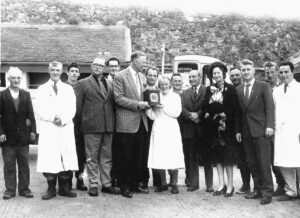Glenroe stars say “cheese”
Miley and Biddy were “knocking around together a long time”
Long before the days of social media celebrities, a huge crowd gathered at the new Shopwell stores in Kilmeaden on Saturday, 12th December 1987 to see TV stars Mick Lally and Mary McEvoy, better known as Miley Byrne and Biddy McDermott of Glenroe fame.
The fictional couple — who “tied the aul knot” a few years earlier — were household names throughout Ireland during the Wicklow-based series’ 1983-2001 run. At the peak of its popularity, the rural soap attracted an incredible 1 million viewers on Sunday nights. And as soon as the closing credits rolled over the familiar theme tune, the kids would be sent to get ready for bed and school the next morning.
It’s hard to credit that the 10th anniversary of Mick’s death occurs later this year. Just 18 months before exiting this mortal stage, the Mayo man reflected on the demise of his most-famous acting part, a reprise of his old Bracken role, which followed hot on the heels of the ‘Ballroom of Romance’. The end of Glenroe, to the central character at least, came as a shock.
“The most it required was not to be taken off, but to be revamped,” maintained Mick, whose wife was killed off in a car crash the previous season. “Get in more writers, develop more storylines, bring in more characters and put it on more often. Whatever was wrong with it was easily fixed, but I think there was always a coterie in RTÉ who were uncomfortable with it. It was a bit too ‘culchie’ for a modern Ireland. I think it’s a pity because, by and large, everything is Dublin based, and you’d swear there was nothing outside of the Pale. RTÉ seems to be more a station for the city than a station for the country,” said Mick, whose voice, of course, became synonymous with Kilmeaden and the ‘Fillet of Cheddar’.
His on-screen ‘other half’ agreed, saying in 2012: “It’s a show that survived by accident and was popular with people, but I believe it was an inconvenience to RTE. At the time it was cancelled we were becoming an increasingly urban society, and I think we country people were the unwanted at that stage. We were an embarrassment in general, with our country image, and the urban Dublin arts press never had much time for us or even for television in general,” Mary contended.
Like most things, it was often criticised when it was top of the TAM ratings, but for many of a certain generation, not least those non-fans of Fair City, telly hasn’t been the same since at all, at all.
Main photo by Joe Evans, Waterford News & Star







Post Comment